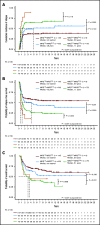Clinical implications of sequential MRD monitoring by NGS at 2 time points after chemotherapy in patients with AML
- PMID: 33999144
- PMCID: PMC8152512
- DOI: 10.1182/bloodadvances.2020003738
Clinical implications of sequential MRD monitoring by NGS at 2 time points after chemotherapy in patients with AML
Abstract
Next-generation sequencing (NGS) has been applied to measurable/minimal residual disease (MRD) monitoring after induction chemotherapy in patients with acute myeloid leukemia (AML), but the optimal time point for the test remains unclear. In this study, we aimed to investigate the clinical significance of NGS MRD at 2 different time points. We performed targeted NGS of 54 genes in bone marrow cells serially obtained at diagnosis, first complete remission (first time point), and after the first consolidation chemotherapy (second time point) from 335 de novo AML patients. Excluding DNMT3A, TET2, and ASXL1 mutations, which are commonly present in individuals with clonal hematopoiesis of indeterminate potential, MRD could be detected in 46.4% of patients at the first time point (MRD1st), and 28.9% at the second time point (MRD2nd). The patients with detectable NGS MRD at either time point had a significantly higher cumulative incidence of relapse and shorter relapse-free survival and overall survival. In multivariate analysis, MRD1st and MRD2nd were both independent poor prognostic factors. However, the patients with positive MRD1st but negative MRD2nd had a similar good prognosis as those with negative MRD at both time points. The incorporation of multiparameter flow cytometry and NGS MRD revealed that the presence of NGS MRD predicted poorer prognosis among the patients without detectable MRD by multiparameter flow cytometry at the second time point but not the first time point. In conclusion, the presence of NGS MRD, especially after the first consolidation therapy, can help predict the clinical outcome of AML patients.
© 2021 by The American Society of Hematology.
Conflict of interest statement
Conflict-of-interest disclosure: H.-F.T., W.-C.C., and H.-A.H. received research funding from Celgene. The remaining authors declare no competing financial interests.
Figures



Similar articles
-
Clinical impact of panel-based error-corrected next generation sequencing versus flow cytometry to detect measurable residual disease (MRD) in acute myeloid leukemia (AML).Leukemia. 2021 May;35(5):1392-1404. doi: 10.1038/s41375-021-01131-6. Epub 2021 Feb 8. Leukemia. 2021. PMID: 33558666 Free PMC article.
-
Posttransplantation MRD monitoring in patients with AML by next-generation sequencing using DTA and non-DTA mutations.Blood Adv. 2021 May 11;5(9):2294-2304. doi: 10.1182/bloodadvances.2021004367. Blood Adv. 2021. PMID: 33929500 Free PMC article.
-
Prognostic Value of FLT3-Internal Tandem Duplication Residual Disease in Acute Myeloid Leukemia.J Clin Oncol. 2023 Feb 1;41(4):756-765. doi: 10.1200/JCO.22.00715. Epub 2022 Oct 31. J Clin Oncol. 2023. PMID: 36315929 Free PMC article.
-
Minimal residual disease monitoring in acute myeloid leukemia: Focus on MFC-MRD and treatment guidance for elderly patients.Eur J Haematol. 2024 Jun;112(6):870-878. doi: 10.1111/ejh.14187. Epub 2024 Feb 11. Eur J Haematol. 2024. PMID: 38342613 Review.
-
Minimal/Measurable Residual Disease Monitoring in NPM1-Mutated Acute Myeloid Leukemia: A Clinical Viewpoint and Perspectives.Int J Mol Sci. 2018 Nov 6;19(11):3492. doi: 10.3390/ijms19113492. Int J Mol Sci. 2018. PMID: 30404199 Free PMC article. Review.
Cited by
-
Development of a Next-generation Sequencing-based Gene Panel Test to Detect Measurable Residual Disease in Acute Myeloid Leukemia.Ann Lab Med. 2023 Jul 1;43(4):328-336. doi: 10.3343/alm.2023.43.4.328. Epub 2023 Feb 24. Ann Lab Med. 2023. PMID: 36843401 Free PMC article.
-
Targeting Measurable Residual Disease (MRD) in Acute Myeloid Leukemia (AML): Moving beyond Prognostication.Int J Mol Sci. 2023 Mar 1;24(5):4790. doi: 10.3390/ijms24054790. Int J Mol Sci. 2023. PMID: 36902217 Free PMC article. Review.
-
How to Improve Prognostication in Acute Myeloid Leukemia with CBFB-MYH11 Fusion Transcript: Focus on the Role of Molecular Measurable Residual Disease (MRD) Monitoring.Biomedicines. 2021 Aug 3;9(8):953. doi: 10.3390/biomedicines9080953. Biomedicines. 2021. PMID: 34440157 Free PMC article. Review.
-
Targeted Therapies and Druggable Genetic Anomalies in Acute Myeloid Leukemia: From Diagnostic Tools to Therapeutic Interventions.Cancers (Basel). 2021 Sep 19;13(18):4698. doi: 10.3390/cancers13184698. Cancers (Basel). 2021. PMID: 34572925 Free PMC article.
-
Molecular Minimal Residual Disease Detection in Acute Myeloid Leukemia.Cancers (Basel). 2021 Oct 29;13(21):5431. doi: 10.3390/cancers13215431. Cancers (Basel). 2021. PMID: 34771594 Free PMC article. Review.
References
-
- Ivey A, Hills RK, Simpson MA, et al. ; UK National Cancer Research Institute AML Working Group . Assessment of minimal residual disease in standard-risk AML. N Engl J Med. 2016;374(5):422-433. - PubMed
-
- Hourigan CS, Gale RP, Gormley NJ, Ossenkoppele GJ, Walter RB. Measurable residual disease testing in acute myeloid leukaemia. Leukemia. 2017;31(7):1482-1490. - PubMed
Publication types
MeSH terms
LinkOut - more resources
Full Text Sources
Other Literature Sources
Medical

